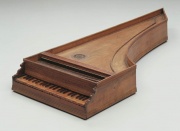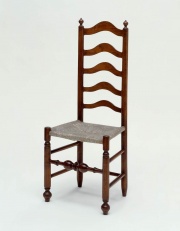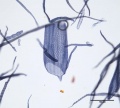Difference between revisions of "Maple"
JMcGlinchey (talk | contribs) |
m (Text replace - "\[http:\/\/cameo\.mfa\.org\/materials\/fullrecord\.asp\?name=([^\s]+)\s(.*)\]" to "$2") |
||
| (One intermediate revision by the same user not shown) | |||
| Line 2: | Line 2: | ||
== Description == | == Description == | ||
| − | A commonly found deciduous tree of the genus ''Acer'' native to North America. The [ | + | A commonly found deciduous tree of the genus ''Acer'' native to North America. The [[sugar%20maple|sugar maple]] (''Acer saccharum'') is the most commercially important tree. While known for its sap, the hard, durable sugar maple wood is used for dance floors, bowling alleys, furniture, cabinetry, musical instruments and veneer. Wood from softer maples, such as the [[red%20maple|red maple]] (''Acer rubrum''), is used for engraving blocks and carving. The bark and leaves of the red maple can also be used to make lightfast brown or black dyes. In general, maple wood has a fine texture with a straight grain. The medium weight wood is sufficiently durable for all purposes. Bird's eye maple and other figuring patterns are popular for decorative work. |
[[File:62.1190-E3185CR-d1.jpg|thumb|]] | [[File:62.1190-E3185CR-d1.jpg|thumb|]] | ||
| Line 37: | Line 37: | ||
</gallery> | </gallery> | ||
| − | == | + | == Sources Checked for Data in Record == |
* R.J. Adrosko, ''Natural Dyes in the United States'', Smithsonian Institution Press, Washington, DC, 1968 | * R.J. Adrosko, ''Natural Dyes in the United States'', Smithsonian Institution Press, Washington, DC, 1968 | ||
Revision as of 13:15, 9 May 2016
Description
A commonly found deciduous tree of the genus Acer native to North America. The Sugar maple (Acer saccharum) is the most commercially important tree. While known for its sap, the hard, durable sugar maple wood is used for dance floors, bowling alleys, furniture, cabinetry, musical instruments and veneer. Wood from softer maples, such as the Red maple (Acer rubrum), is used for engraving blocks and carving. The bark and leaves of the red maple can also be used to make lightfast brown or black dyes. In general, maple wood has a fine texture with a straight grain. The medium weight wood is sufficiently durable for all purposes. Bird's eye maple and other figuring patterns are popular for decorative work.
Synonyms and Related Terms
harewood; silkwood; sugar maple (Acer saccharum); red maple (Acer rubrum); Løn-slægten (Dan.); Ahorn (Deut.); acero (It.); arce (Esp.); bordo (Port.); érable (Fr.); esdoorn (Ned.); Klon (Pol.); Lönnar (Sven.)
Other Properties
Light reddish brown wood. Small pores. Distinct rings. Rays show as fine dashes in quarter sawed wood.
| Density | 39-50 ppcf |
|---|
Paper fiber type: hardwood, diffuse porous. Using transmitted light microscopy, pulp is identified by short vessels with prominent spiral thickening. Pitting on vessels is alternate. Perforations are simple. Appearance with Graff "C" stain: dark blue, but varies with bleaching. Average dimensions of fibers: length 0.7-1.1mm, 10-20μm wide. Common pulping method: kraft.
Additional Information
Schoch, W., Heller, I., Schweingruber, F.H., Kienast, F., 2004:Wood anatomy of central European Species: Norway Maple,Acer platanoides L.
Additional Images
Sources Checked for Data in Record
- R.J. Adrosko, Natural Dyes in the United States, Smithsonian Institution Press, Washington, DC, 1968
- Ralph Mayer, A Dictionary of Art Terms and Techniques, Harper and Row Publishers, New York, 1969 (also 1945 printing)
- F. H. Titmuss, Commercial Timbers of the World, The Technical Press Ltd., London, 1965 Comment: 40-50 ppcf
- Dictionary of Building Preservation, Ward Bucher, ed., John Wiley & Sons, Inc., New York City, 1996
- Encyclopedia Britannica, http://www.britannica.com Comment: "maple" Encyclopædia Britannica [Accessed October 24, 2001].
- Edward Reich, Carlton J. Siegler, Consumer Goods: How to Know and Use Them, American Book Company, New York City, 1937
- Wikipedia, the free encyclopedia, at http://www.wikipedia.com Comment: http://en.wikipedia.org/wiki/Maple (Accessed Sept. 30, 2005)
- G.S.Brady, Materials Handbook, McGraw-Hill Book Co., New York, 1971 Comment: p. 498
- Random House, Webster's Encyclopedic Unabridged Dictionary of the English Language, Grammercy Book, New York, 1997
- The American Heritage Dictionary or Encarta, via Microsoft Bookshelf 98, Microsoft Corp., 1998
- CRC Handbook of Chemistry and Physics, Robert Weast (ed.), CRC Press, Boca Raton, Florida, v. 61, 1980 Comment: density=39-47 ppcf (0.62-0.75 g/cm3)
- Marja-Sisko Ilvessalo-Pfäffli. Fiber Atlas: Identification of Papermaking Fibers (Springer Series in Wood Science). Springer, 1995.
- Walter Rantanen. "Fiber ID Course." Integrated Paper Services. June 2013. Lecture.








